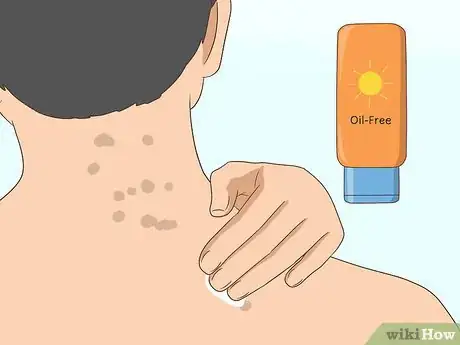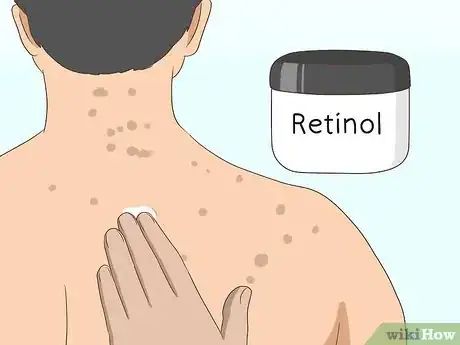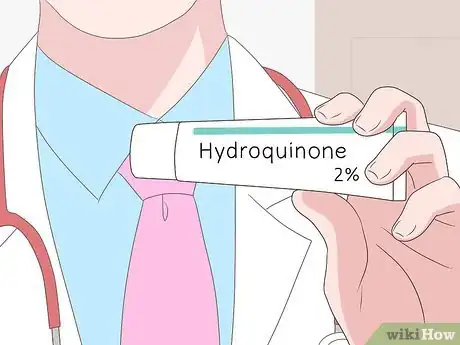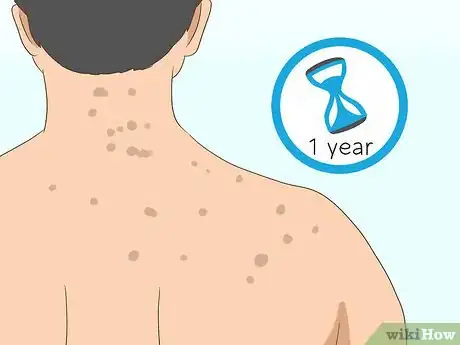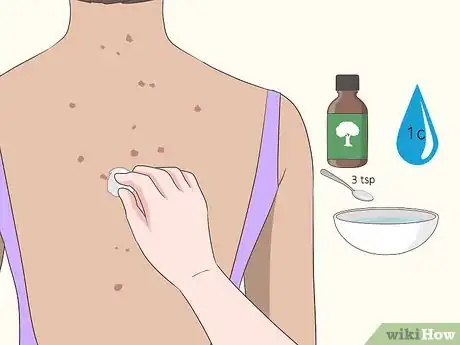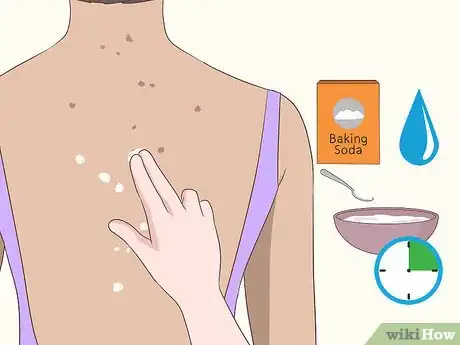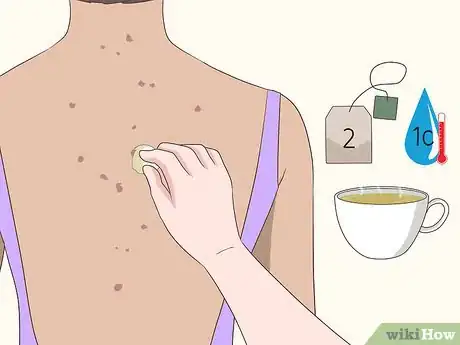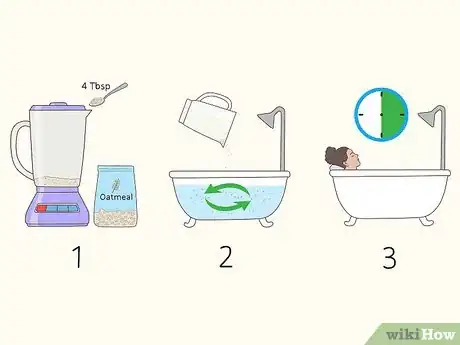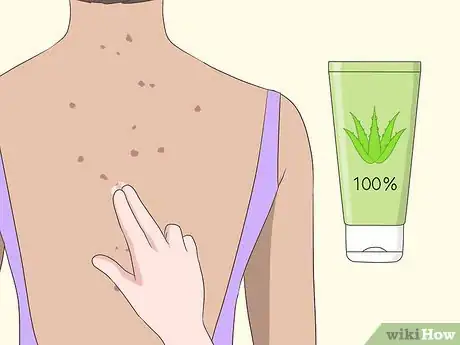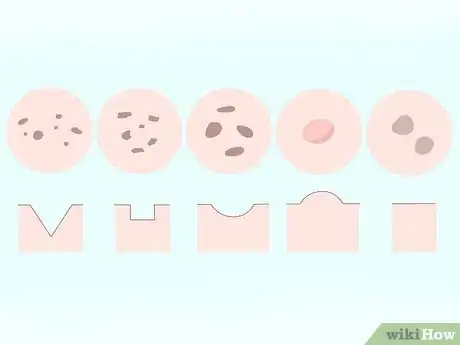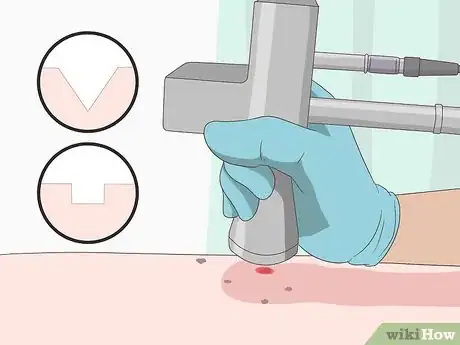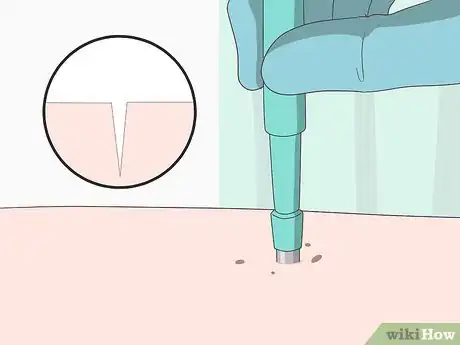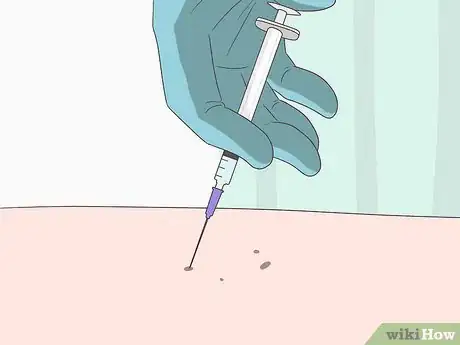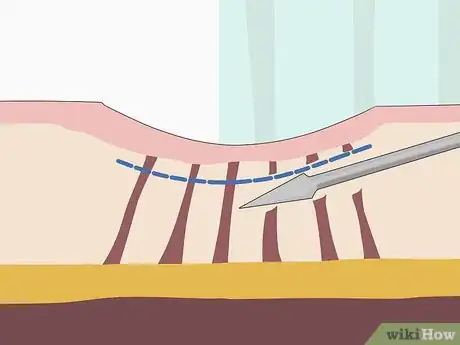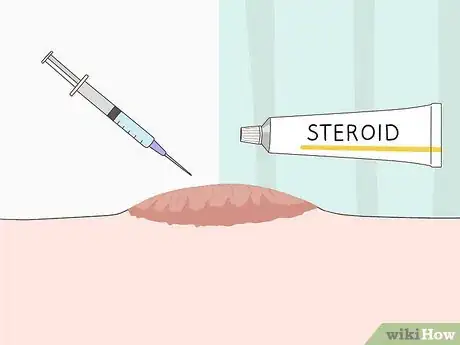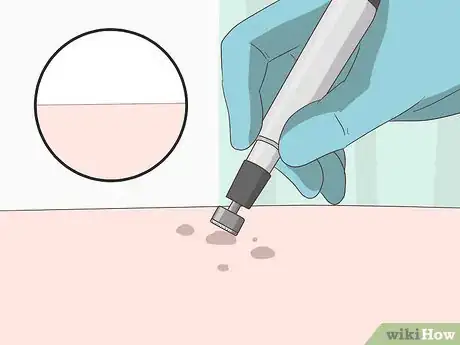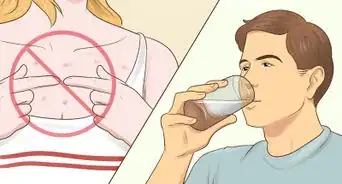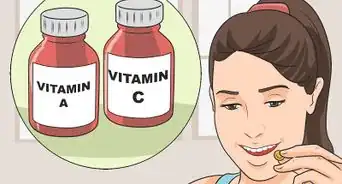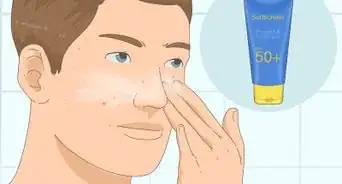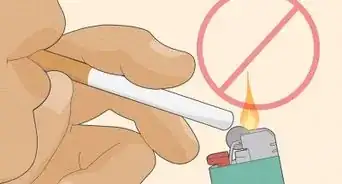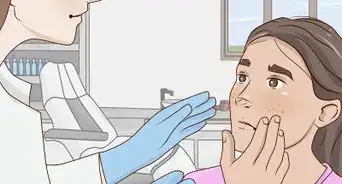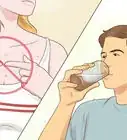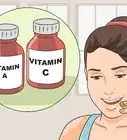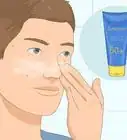This article was co-authored by Mohiba Tareen, MD and by wikiHow staff writer, Christopher M. Osborne, PhD. Mohiba Tareen is a board certified Dermatologist and the founder of Tareen Dermatology located in Roseville, Maplewood and Faribault, Minnesota. Dr. Tareen completed medical school at the University of Michigan in Ann Arbor, where she was inducted into the prestigious Alpha Omega Alpha honor society. While a dermatology resident at Columbia University in New York City, she won the Conrad Stritzler award of the New York Dermatologic Society and was published in The New England Journal of Medicine. Dr. Tareen then completed a procedural fellowship which focused on dermatologic surgery, laser, and cosmetic dermatology.
There are 7 references cited in this article, which can be found at the bottom of the page.
This article has been viewed 165,028 times.
Back acne scarring might make you self-conscious about your appearance, and may cause skin irritation and discomfort in some cases. If your scarring is mostly skin discoloration, which is the most common type on the back, certain over-the-counter skin products may help over time. You can also try different home remedies to get rid of all types of back acne scarring—they’re usually harmless but also medically unproven. For recurring or significant scarring, though, your best bet is to consult your dermatologist for a proper diagnosis and treatment plan.
Steps
Applying Products for Discoloration Scars
-
1Apply an oil-free sunscreen to prevent further scar darkening. Back acne discoloration scars are typically darker than your surrounding skin, and sun exposure will only further darken them. So, if your discoloration scars are on your shoulders, the back of your neck, or another area that receives sunshine regularly, apply a broad-spectrum sunscreen to limit further darkening of the skin.[1]
- Look for an oil-free sunscreen meant for sensitive skin. Oily sunscreens may contribute to additional acne breakouts.
- Cover the area with clothing (e.g., by avoiding low-back tank tops) whenever possible as well, but apply sunscreen even when the area is covered with clothing.
-
2Increase cell replacement with a wrinkle cream containing retinol. Retinol speeds up skin cell replacement, which is why it can help reduce the appearance of wrinkles. Retinol can also speed up the replacement of the discolored skin cells found on your back.[2]
- Apply the product as directed to your skin, focusing on your back acne discoloration scars. You may need to enlist the help of a friend to apply it to hard-to-reach spots on your back.
Advertisement -
3Ask your doctor about fading creams with hydroquinone. Hydroquinone speeds up the fading of skin discoloration spots, and creams with up to 2% hydroquinone are available without a prescription in the U.S. However, in some cases, it may cause skin irritation or additional skin discoloration, so you may want to consult your dermatologist before using it.[3]
- Apply the product as directed on the package or by your dermatologist.
- Hydroquinone is banned in Europe due to concerns over skin reactions, which can include skin dryness, redness, irritation, and sometimes cracking, blistering, and bleeding.[4]
-
4Wait it out and let the discoloration fade. The most common type of back acne scar isn’t actually a scar, but rather post-inflammatory hyperpigmentation—that is, a temporary discoloration of the skin. In most cases, this pink, red, purple, brown, or black discoloration (that is neither raised above nor pitted below the skin) will fade on its own within about 12 months.[5]
- If you run your fingers over your back and the skin feels generally smooth, most of your back acne scarring is likely actually post-inflammatory hyperpigmentation. However, the only way to know for sure is to visit your dermatologist.
- Treating other types of back acne scarring with post-inflammatory hyperpigmentation treatments is very unlikely to cause any further problems, but also unlikely to significantly improve the scarring.
- Post-inflammatory hyperpigmentation can also occur after cuts, scrapes, and other injuries to the skin, and all the remedies mentioned here should be equally effective in those cases as well.
Giving Home Remedies a Try
-
1Apply tea tree oil 2-3 times daily. Stir 2–3 tsp (9.9–14.8 ml) of tea tree oil into 1 c (240 ml) of lukewarm water. Use cotton balls or swabs to apply the mixture to your back acne scars 2-3 times per day.[6]
- Tea tree oil has possible anti-inflammatory and antiseptic properties, which may make it useful as an acne scar treatment.
- As with other home remedy treatments, there is little to no medical evidence that tea tree oil works for reducing back acne scars.
- Also, like with other home remedies, it may be difficult for you to reach the acne scars on your back yourself. You may need to enlist the services of a helper to apply the treatment.
-
2Put on a baking soda paste for 10-15 minutes. Add a spoonful or two of baking soda to a bowl, then stir in just enough lukewarm water to create a thick paste. Use your fingers to apply the paste to your back acne scars, massaging it in gently to help exfoliate your skin. Rinse the paste away after 10-15 minutes.[7]
- This is ideal to do once daily before you take a shower, which is the easiest way to rinse the baking soda paste off your back.
- Baking soda may provide some antibacterial and anti-inflammatory properties, and it serves as an exfoliator that may help reduce the appearance of your back acne scars.
- If you have red, inflamed acne on your back, do not exfoliate it. That will make the inflammation worse.[8]
-
3Brew up green tea and apply it to the scars. Steep 2 tbsp (30 g) of loose green tea, or 2-3 tea bags, in 1 c (240 ml) of hot water for 10-20 minutes. Use cotton balls, cotton swabs, or a washcloth to apply the brewed green tea to your back acne scars 2-3 times per day.[9]
- The antioxidants in green tea may provide anti-inflammatory benefits to reduce scarring.
- Drinking 2-3 cups of brewed green tea per day might also potentially be helpful.
-
4Add ground oatmeal to your bath water. Grind up 4 tbsp (60 g) of plain oatmeal into a fine powder with a blender or spice grinder, then vigorously stir it into your bathwater so it doesn’t just sink to the bottom. Soak in the tub for around 30 minutes. You can repeat this process daily.[10]
- Alternatively, you can mix the ground oatmeal with honey to make a paste and apply it to your back acne for 15-20 minutes, then rinse it away.
- Oatmeal acts as an exfoliant and may help reduce skin irritation and inflammation.
Expert AnswerQIs there anything I can do to prevent back acne?
Mohiba Tareen is a board certified Dermatologist and the founder of Tareen Dermatology located in Roseville, Maplewood and Faribault, Minnesota. Dr. Tareen completed medical school at the University of Michigan in Ann Arbor, where she was inducted into the prestigious Alpha Omega Alpha honor society. While a dermatology resident at Columbia University in New York City, she won the Conrad Stritzler award of the New York Dermatologic Society and was published in The New England Journal of Medicine. Dr. Tareen then completed a procedural fellowship which focused on dermatologic surgery, laser, and cosmetic dermatology.FAAD Board Certified Dermatologist
 EXPERT ADVICEAnswer from Mohiba Tareen, MD:
EXPERT ADVICEAnswer from Mohiba Tareen, MD:The skin on your back is a lot thicker than other parts of your body, so it can be difficult to treat acne there. The main tips I recommend are to always shower right after you work out, and to avoid really tight clothing like a sports bra or trainer after you work out. Also, shower with a wash that has an ingredient like glycolic acid, lactic acid, salicylic acid, or benzoyl peroxide. If you're trying this and you still have significant back acne, it may be necessary to go on oral medication (because topical medications have a difficult time penetrating into that thick skin).
-
5Dab aloe vera gel on your back acne scars. Either buy 100% aloe vera gel at the store or, even better, extract it from an aloe vera plant by cutting open fresh leaves. Apply the gel to your back acne scars with your fingers twice per day.[11]
- Aloe may help soften your skin, reduce irritation, boost skin cell growth, and serve as an antifungal agent.
- It’s possible, but of course far from guaranteed, that you may see improvement within several days to several weeks.
Getting Dermatological Treatment
-
1Let the dermatologist diagnose your type(s) of back acne scarring. Not all back acne scars are the same, and different treatments work best for different types of scars. Visit a dermatologist to get an accurate diagnosis of your back acne scar type and the recommended treatments. The most common scar types are:[12]
- “Ice-pick” scars: narrow, deep scars
- “Boxcar” scars: deep circular or oval scars with steep sides
- Rolling scars: undulating, wave-like scars with undefined edges
- Hypertrophic scars: raised scars
- Post-inflammatory hyperpigmentation: not raised or pitted, not technically a scar, and the most common type of back acne “scar”— a discoloration that can be pink, red, purple, brown, or black
-
2Try laser treatments for “ice-pick” or “boxcar” scars. Ablative laser treatments remove the top layers of skin, which stimulates the growth of new tissue without the scarring. Many dermatologists offer this treatment, and it’s relatively quick and painless. However, you will experience redness in the treated areas for at least 2 weeks and possibly up to several months.[13]
- Non-ablative laser treatments don’t destroy the top layers of skin, and instead stimulate new skin-tightening collagen formation from beneath. They’re quick, painless, and leave no redness, but are only useful for hyperpigmentation or very minor scars.[14]
- It takes weeks to months for the skin to regenerate without the scars, so this isn't a quick fix.
-
3Undergo punch excision, elevation, or grafting for deep scars. All of these “punch” techniques use tools that are similar in a way to tiny cookie cutters. They punch out (remove) the scar tissue, then the area is sutured. The scarring from the sutures will fade over time.[15]
- Punch grafting includes using skin grafts (usually from behind the ear) to replace the tissue from very large acne scars.
- While you’re trading one type of scar for another, the suture scarring will usually disappear within several months. Your dermatologist might use dermabrasion treatments to speed the process along.
-
4Have dermal fillers injected to raise pitted scars quickly. With this treatment, your dermatologist injects a substance (often bovine collagen or fat from elsewhere in your body) beneath the deep scars, raising them to surface level. This is a temporary measure, however, and will need to be repeated every several months if you want ongoing results.[16]
- Dermal fillers are a good “quick fix” technique if you want to reduce the look of back acne scars as soon as possible.
-
5See if subcutaneous incisions help with undulating scars. Instead of cutting down into the skin, subcutaneous incisions (or subcisions) are cut parallel to and just beneath the skin’s surface. This process severs the tissue bands that tether the skin in place, allowing it to raise up and smooth out.[17]
- This treatment works best on rolling scars that create a wavy texture on your skin.
- Your dermatologist can perform this procedure quickly using local anesthesia.
- You can see immediate results with this procedure, but you may have some minor discomfort and scarring at the small incision sites.
-
6Use steroid creams or injections for raised scars. Steroids, given either as an injection or topical cream, can help reduce hypertrophic (raised) scars back down to surface level. Your dermatologist may give you injections one or more times in their office, or they may give you a steroid cream to apply to the area daily for several hours, then wipe off.[18]
- Steroid treatments can take several months to be effective.
- If you are given a steroid cream to apply, follow the application instructions exactly as prescribed.
-
7Give dermabrasion or microdermabrasion a try on discoloration scars. Dermabrasion is done under local anesthesia at your dermatologist’s office, and involves the use of a tiny wire brush to scrape away the top layers of your skin. It can remove hyperpigmentation (discoloration) scars as well as smaller ice-pick and boxcar scars. You’ll experience some minor pain at the site for a few days, and redness for up to several weeks.[19]
- Microdermabrasion is more akin to sandblasting, and impacts only the very top layers of skin. As such, it is only effective on discoloration scars. It can be done at day spas as well as medical offices, and usually requires several treatments to be effective.
- You'll have to wait at least a few weeks for the redness to subside before you'll really notice any positive results.
Expert Q&A
Did you know you can get expert answers for this article?
Unlock expert answers by supporting wikiHow
-
QuestionWhat if my back acne won't go away?
 Mohiba Tareen, MDMohiba Tareen is a board certified Dermatologist and the founder of Tareen Dermatology located in Roseville, Maplewood and Faribault, Minnesota. Dr. Tareen completed medical school at the University of Michigan in Ann Arbor, where she was inducted into the prestigious Alpha Omega Alpha honor society. While a dermatology resident at Columbia University in New York City, she won the Conrad Stritzler award of the New York Dermatologic Society and was published in The New England Journal of Medicine. Dr. Tareen then completed a procedural fellowship which focused on dermatologic surgery, laser, and cosmetic dermatology.
Mohiba Tareen, MDMohiba Tareen is a board certified Dermatologist and the founder of Tareen Dermatology located in Roseville, Maplewood and Faribault, Minnesota. Dr. Tareen completed medical school at the University of Michigan in Ann Arbor, where she was inducted into the prestigious Alpha Omega Alpha honor society. While a dermatology resident at Columbia University in New York City, she won the Conrad Stritzler award of the New York Dermatologic Society and was published in The New England Journal of Medicine. Dr. Tareen then completed a procedural fellowship which focused on dermatologic surgery, laser, and cosmetic dermatology.
FAAD Board Certified Dermatologist
References
- ↑ http://nymag.com/strategist/article/how-to-treat-acne-scars-and-marks-2018.html
- ↑ http://nymag.com/strategist/article/how-to-treat-acne-scars-and-marks-2018.html
- ↑ http://nymag.com/strategist/article/how-to-treat-acne-scars-and-marks-2018.html
- ↑ https://www.rxlist.com/consumer_hydroquinone_melquin_3/drugs-condition.htm
- ↑ https://kidshealth.org/en/teens/acne-scars.html
- ↑ https://www.well-beingsecrets.com/how-to-get-rid-of-back-acne-scars/
- ↑ https://www.well-beingsecrets.com/how-to-get-rid-of-back-acne-scars/
- ↑ Mohiba Tareen, MD. FAAD Board Certified Dermatologist. Expert Interview. 26 March 2020.
- ↑ https://www.well-beingsecrets.com/how-to-get-rid-of-back-acne-scars/
- ↑ https://www.well-beingsecrets.com/how-to-get-rid-of-back-acne-scars/
- ↑ https://www.well-beingsecrets.com/how-to-get-rid-of-back-acne-scars/
- ↑ https://www.verywellhealth.com/types-of-acne-scars-15812
- ↑ https://kidshealth.org/en/teens/acne-scars.html
- ↑ https://www.verywellhealth.com/acne-scar-treatments-15792
- ↑ https://www.verywellhealth.com/acne-scar-treatments-15792
- ↑ https://www.verywellhealth.com/acne-scar-treatments-15792
- ↑ https://www.verywellhealth.com/acne-scar-treatments-15792
- ↑ https://www.verywellhealth.com/acne-scar-treatments-15792
- ↑ https://kidshealth.org/en/teens/acne-scars.html
- ↑ Mohiba Tareen, MD. FAAD Board Certified Dermatologist. Expert Interview. 26 March 2020.
- ↑ Mohiba Tareen, MD. FAAD Board Certified Dermatologist. Expert Interview. 26 March 2020.
About This Article
If you want to get rid of back acne scars, it's important to apply sunscreen to the affected area any time you plan to be out in the sun to prevent further discoloration and scarring. Keep in mind that discoloration usually fades naturally within a year without treatment, but you can speed things along by applying a retinol cream to the affected area. For additional help with discoloration, talk to your doctor about fading creams that contain hydroquinone, which can speed up the fading process. If you prefer a more natural approach, try applying a tea tree oil solution to the affected area 2 to 3 times a day. For advice on fading scars with laser treatments, scroll down!
